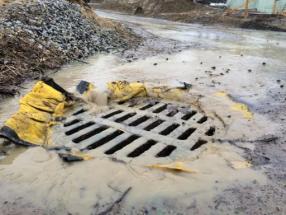Stormwater Runoff Control - Construction Projects

Uncontrolled stormwater runoff from construction sites can significantly impact Gorham's water resources, such as Tannery Brook and the Presumpscot River. Sediment in waterbodies from construction sites can reduce the amount of sunlight reaching aquatic plants, clog fish gills, smother aquatic habitat and spawning areas, impede navigation and add nutrients.
The State's Stormwater (MS4) Permit requires Gorham to develop a program that prevents erosion and sediment from construction activities and protects local water resources. The Town's ordinance has numerous provisions that require developers/owners and contractors to use "Best Management Practices" (BMPs) for erosion and sediment control.
Stormwater management plans are required to be designed utilizing the most recent version of the "Maine Erosion and Sediment Control Notebook for Construction: Best Management Practices" and the "Maine Stormwater Management Design Manual".
The Town strongly encourages property owners and/or developers to use excavation contractors that have been certified by the Maine Department of Environmental Protection (MDEP) in the proper use of erosion and sediment control (ESC) practices.
Low Impact Development
The Town encourages property owners and/or developers to incorporate low impact development techniques.
Low Impact Development (LID) is an inexpensive, simple approach to protecting water quality. The basic strategy is to conserve beneficial natural features of a site, its "green infrastructure", by avoiding unnecessary paving, grading and soil compaction. LID often reduces the cost of development and maintenance.
Basic Features
- Minimize impervious surfaces, such as driveways, roofs, concrete pads and compacted earth.
- Avoid soil disturbance and compaction.
- Protect and expand native vegetation.
- Minimize site clearing.
- Avoid direct connections between impervious area drainage and streams or storm drains.
Documented use of LID techniques can help meet the requirements of a Drainage Plan, as well as Basic and Post-Construction Stormwater Management Plans.
Design and Installation
LID techniques are best implemented in the planning and development stages of a project. Here are some examples:
- Buildings can be sited to result in shorter (and cheaper) driveways with less surface area.
- Remove any excess parking areas, if present. This reduces paving maintenance and snow removal costs in the long run. If overflow parking is needed on rare occasions, consider alternatives to pavement, such as pervious gravel or pavers.
- Avoid removing native vegetation. Work with your contractor to create a space-efficient access plan to the site during construction.
- Minimize the ground area accessible to vehicles during construction, which protests soil from compaction and reduces the need for soil restoration later.
- Reduce the size of intensively-managed turf and lawns, allowing native vegetation to remain or take over where appropriate. Areas that are to remain open can become meadows, by mowing only once or twice a year.
Practices Profiles were issued for recommended LID practices for Maine Communities. The following additional resources are also recommended:
- Maine Stormwater Management Design Manual: Volumes I and III
- The Stormwater Managers Resource Center
- The University of New Hampshire Stormwater Center
- Low Impact Development Urban Design Tools
Maintenance
Thoughtful application of LID techniques to your development or re-development project will reduce maintenance needs by allowing natural vegetation and soil process to protect water quality.
Maine Department of Environmental Protection Documents
"Comply with Maine Erosion and Sediment Control Law" - Handout
"Why You Should Consider Hiring a Contractor Certified in Erosion and Sediment Control" - Information Sheet
"DEP Requires Erosion and Sediment Control Certification for Contractors Working in Shoreland Zone" - News Article
Photo and Content Credit: City of South Portland, Maine Coastal Program
